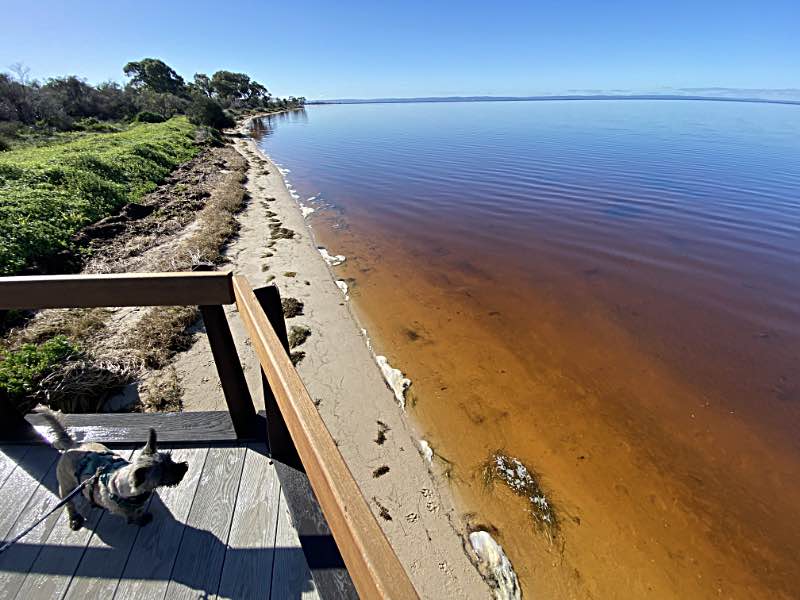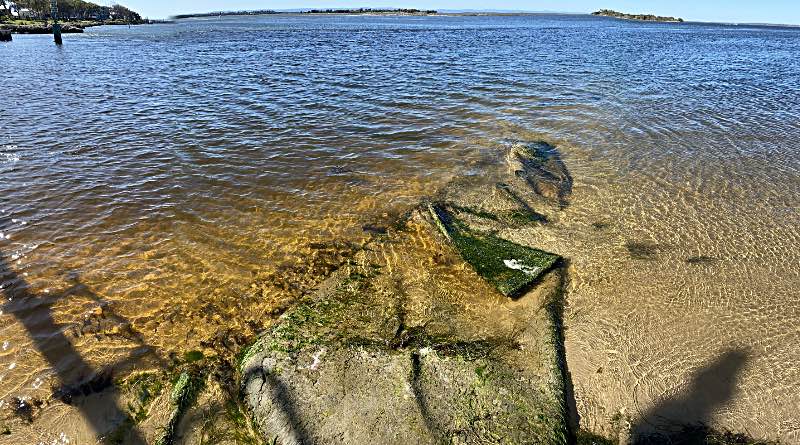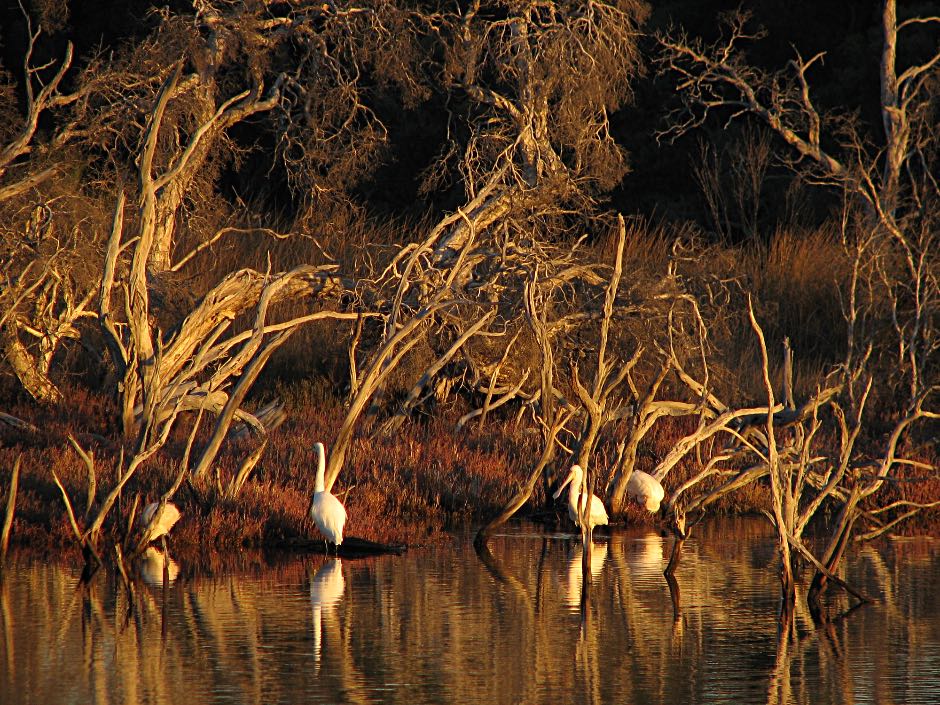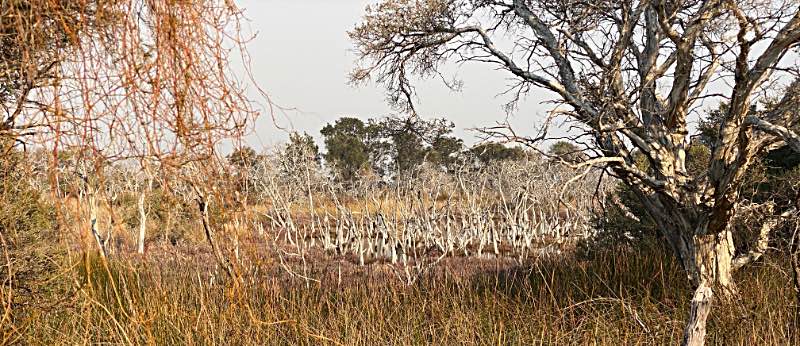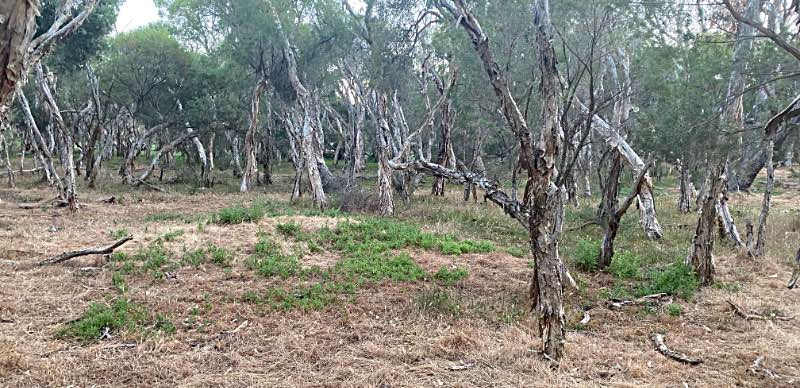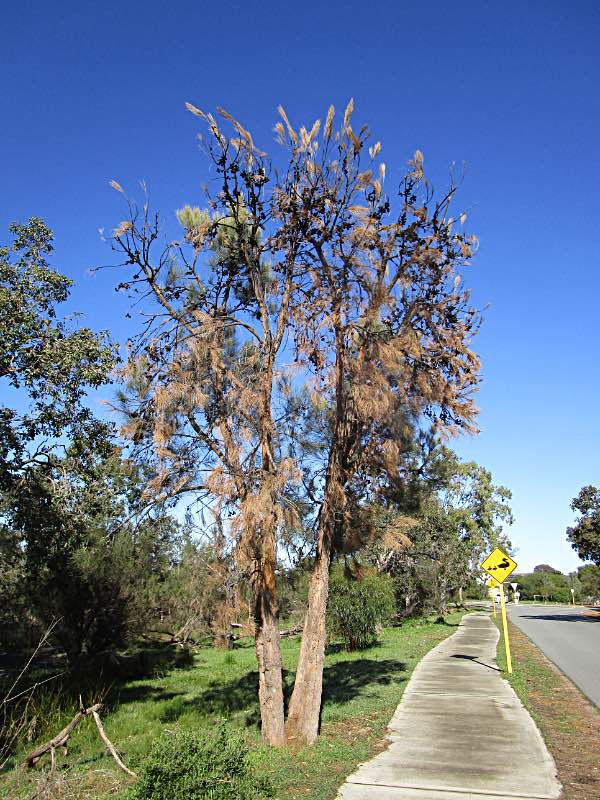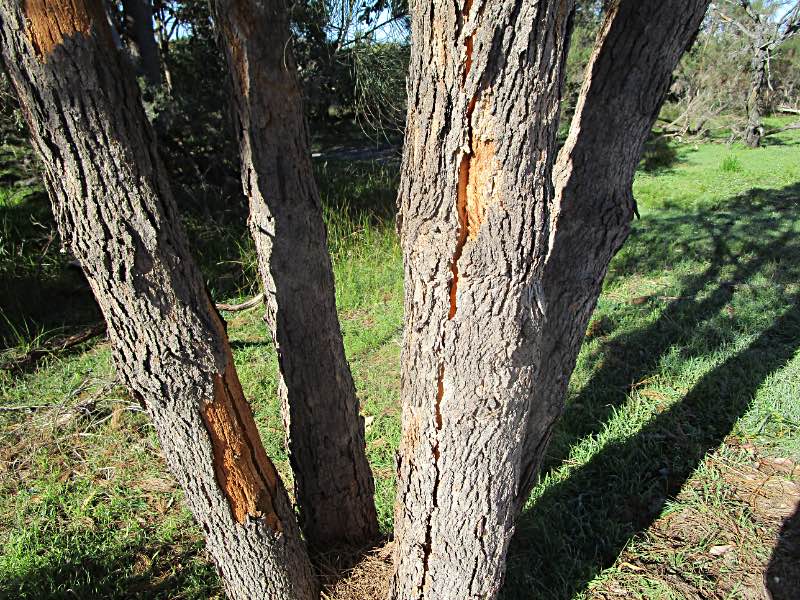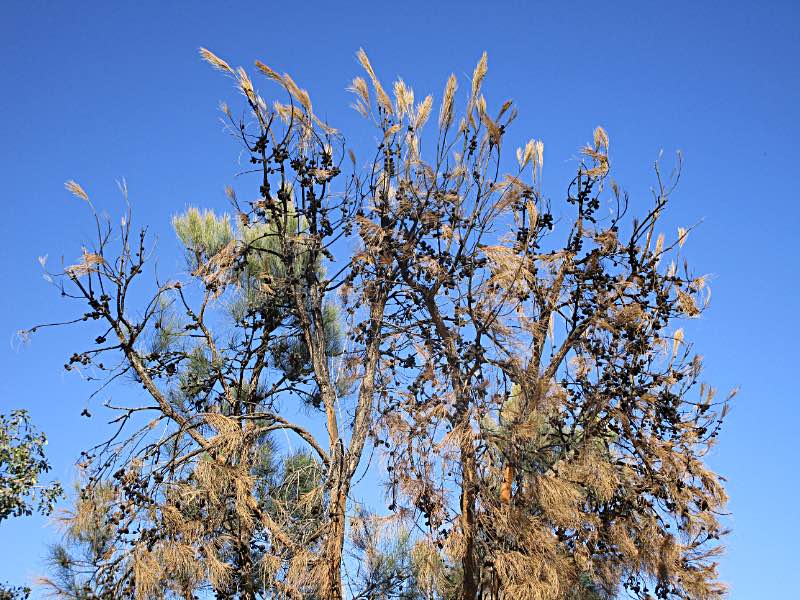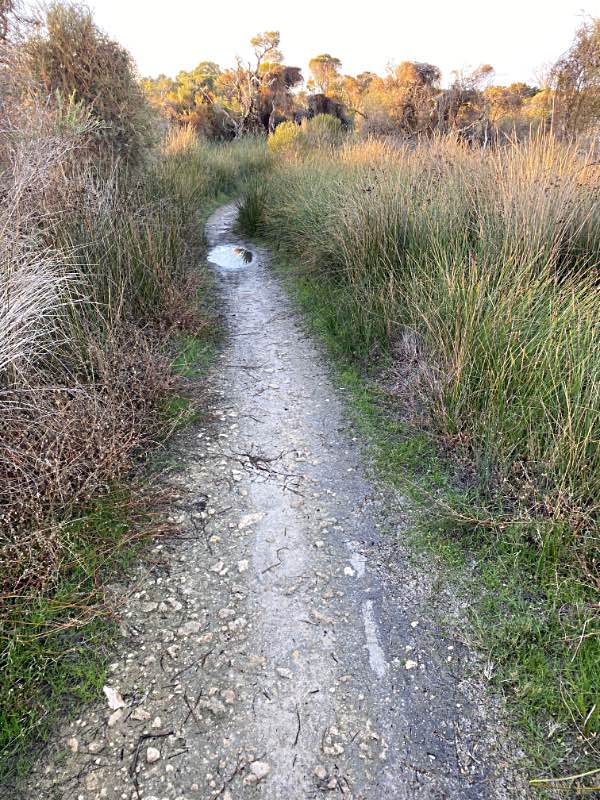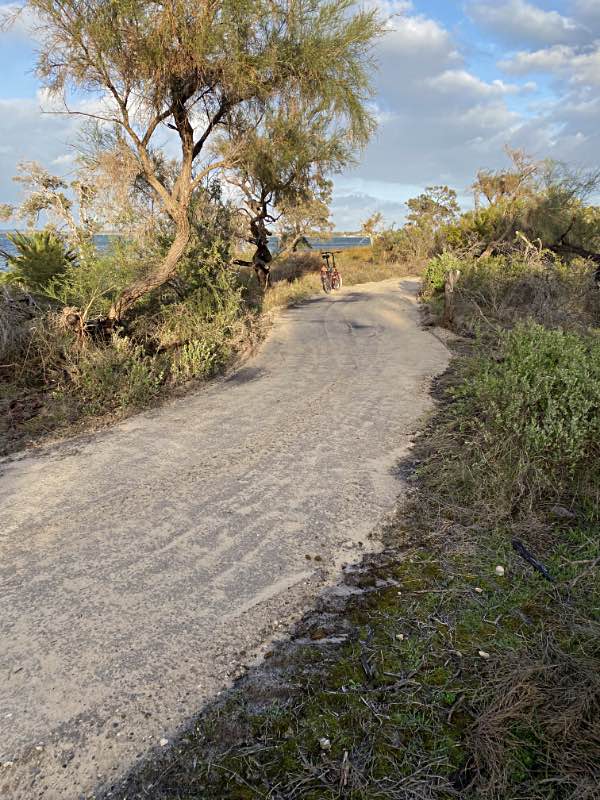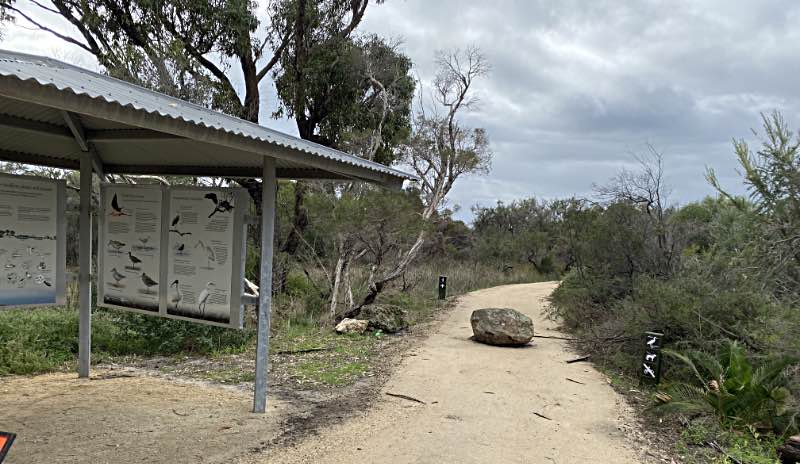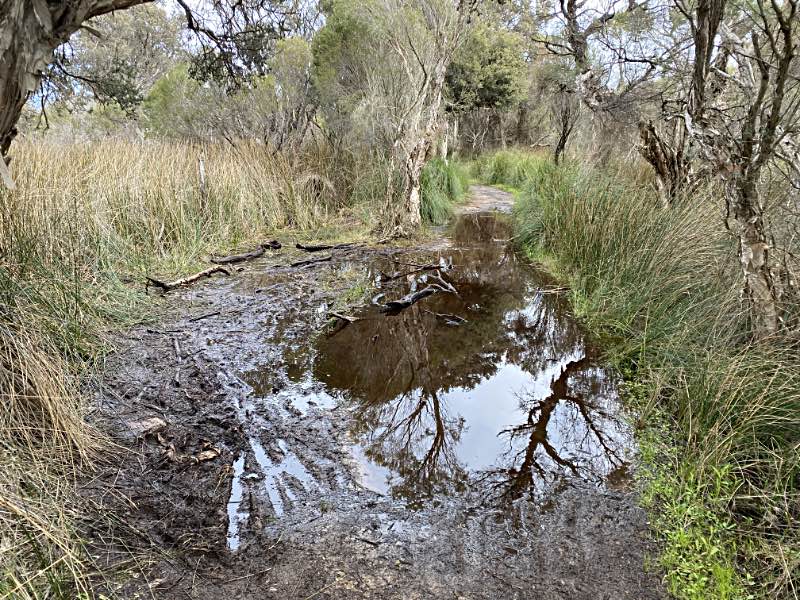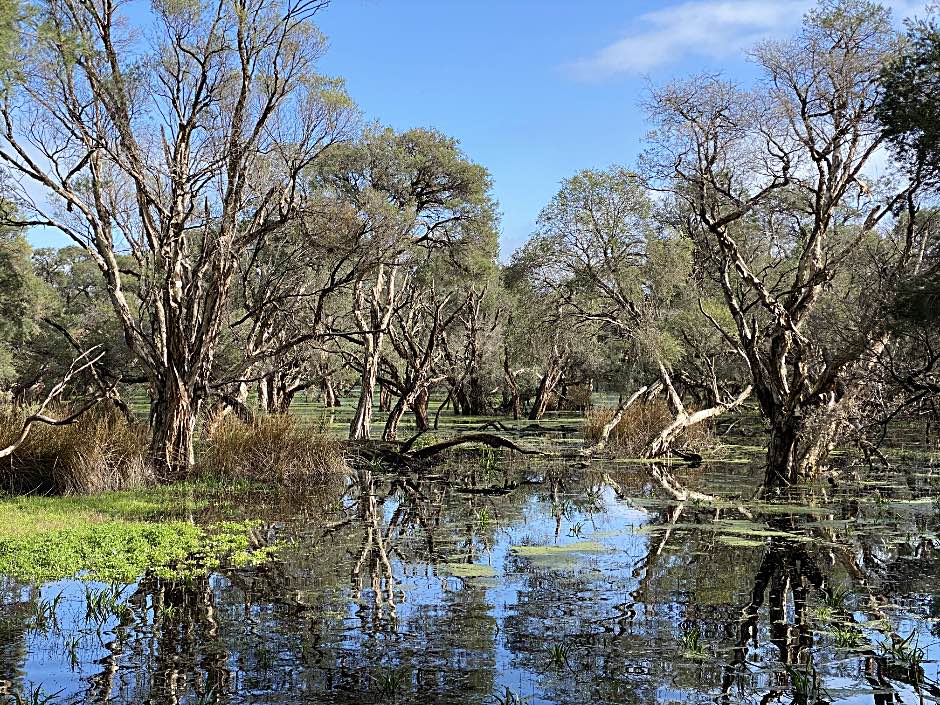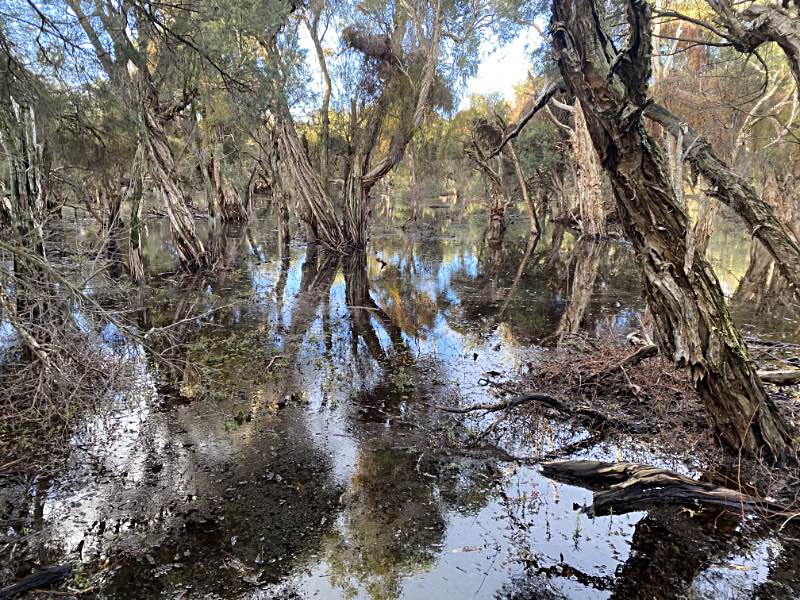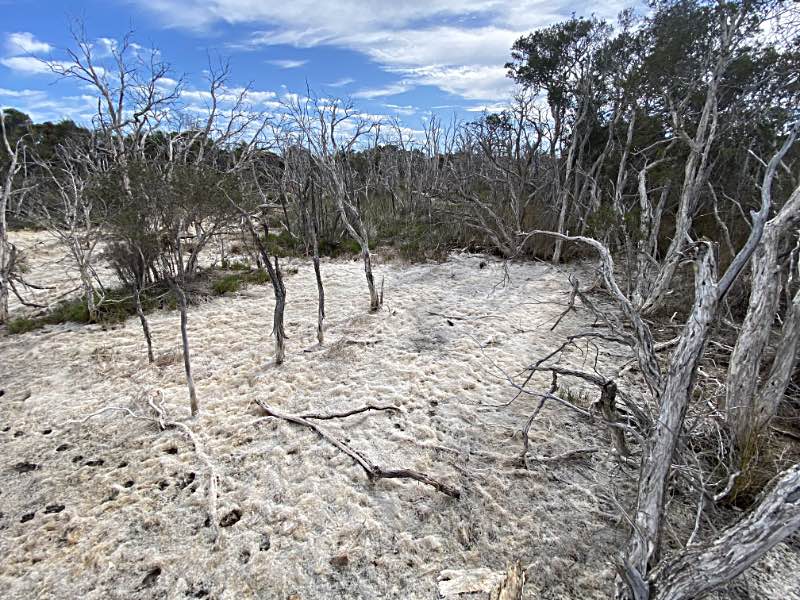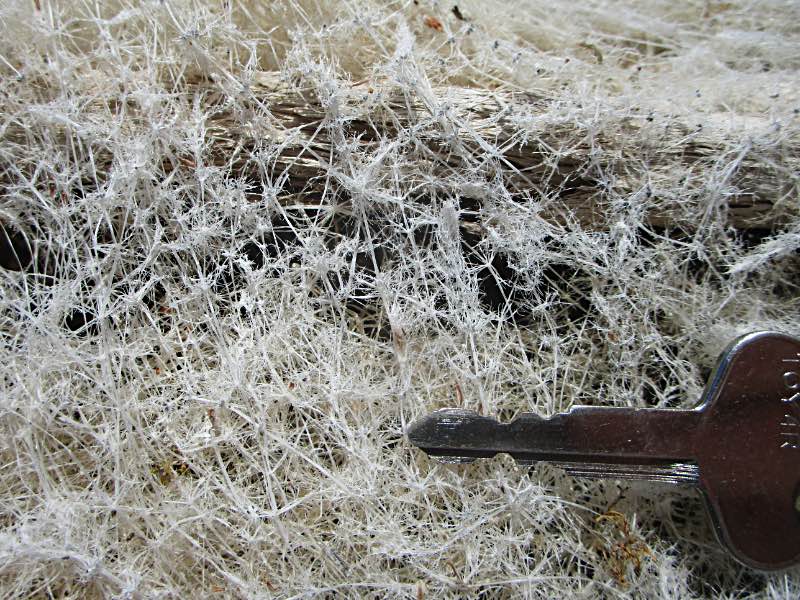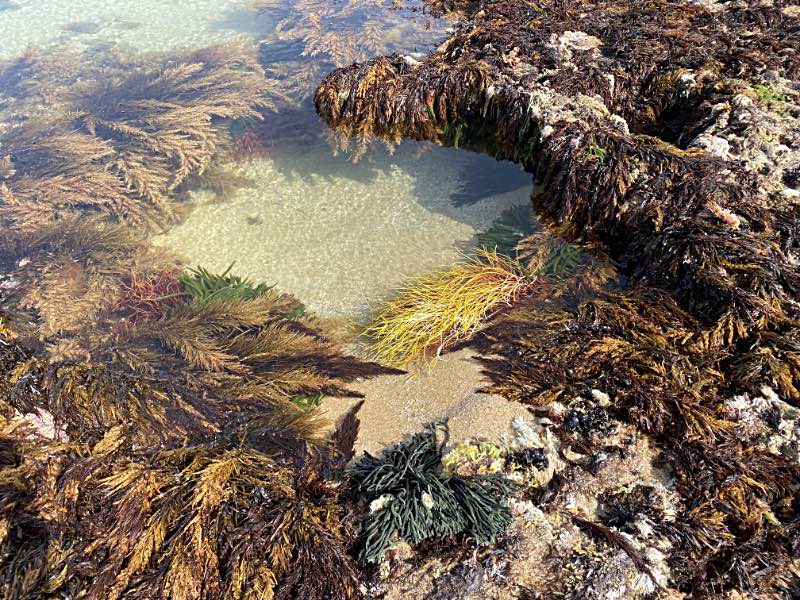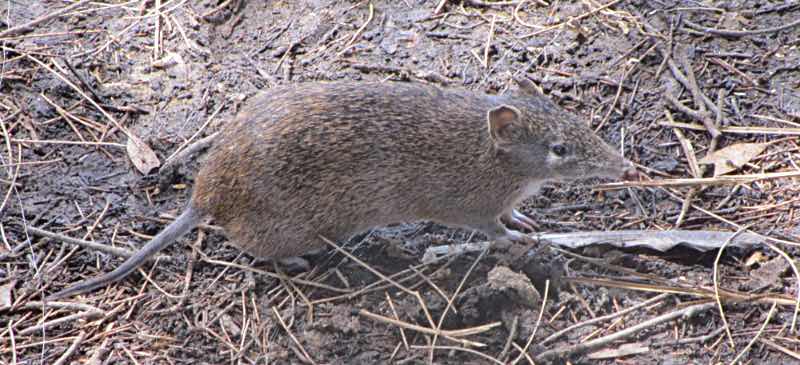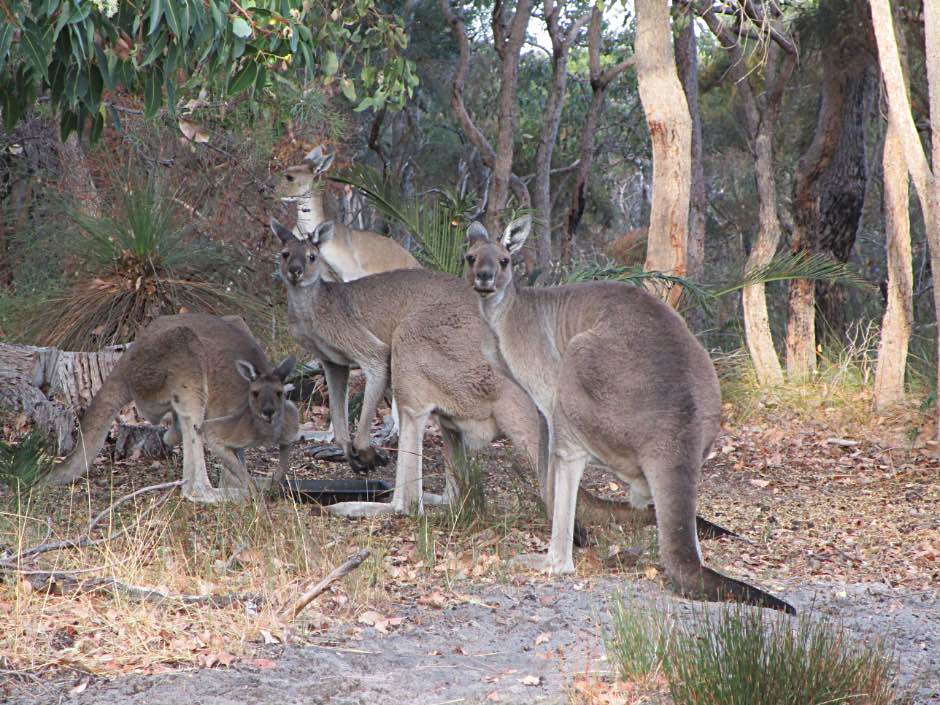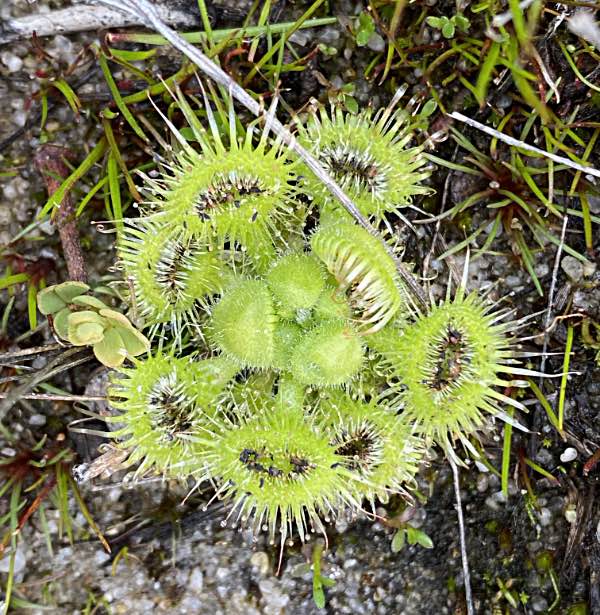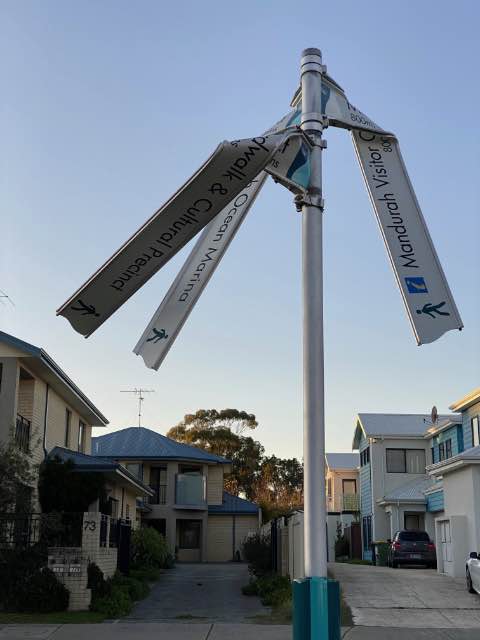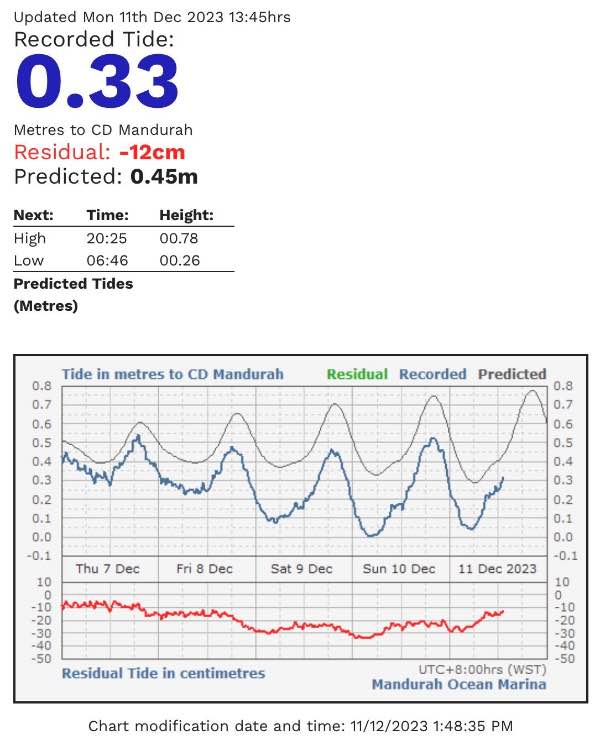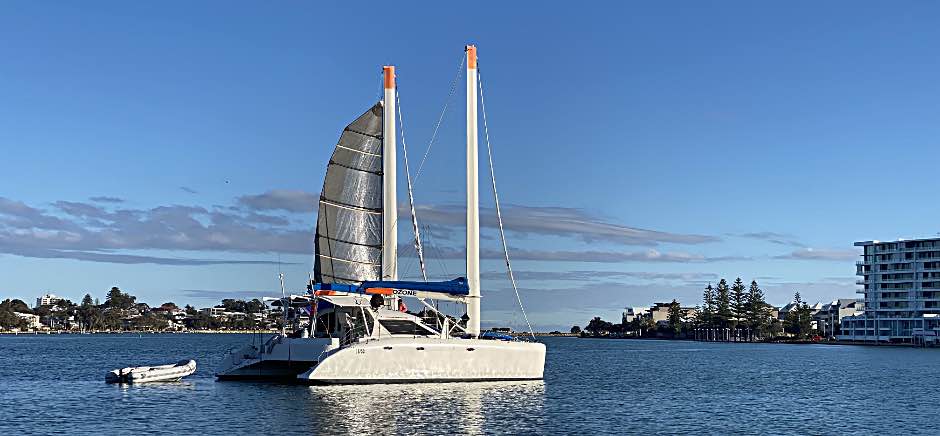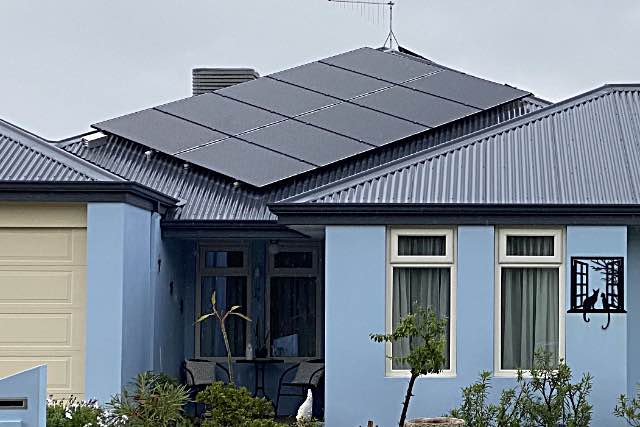The kangaroos that live in the Len Howard CP are very relaxed around people.
Many times we have seen them grazing on someone's front lawn. I've seen one hop through a front gate to do some grazing in mid morning.
In the period at least from February 2022 to the end of 2022 there was a mob of 25 or more kangaroos resident in the BSPS. If anything these kangaroos are even more relaxed around people than those that use the feeding station mentioned above. The most relaxed one of them all is possibly the injured kangaroo mentioned elsewhere on this page.
| |
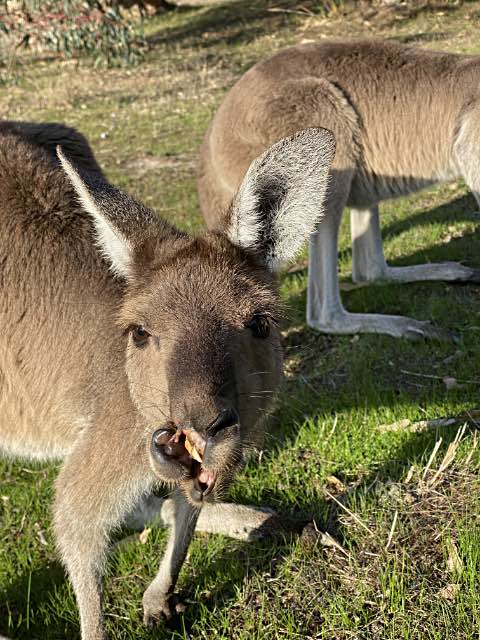
| Photo 2022/05/25
|
|
|
|
|
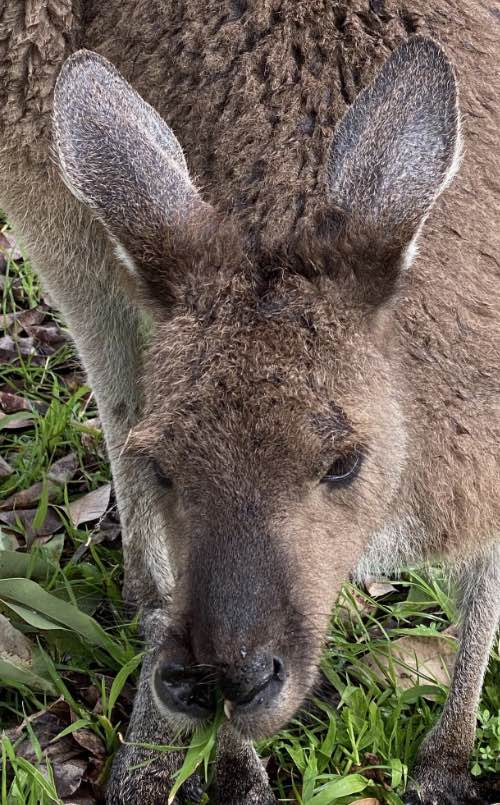
| Photo 2022/08/13
| |
Added comment
Early this morning (2022/05/05), when there was hardly any daylight, I was walking through the little
reserve at the western intersection of Silverton Crescent and Wattleglen Avenue on my way to do a fortnightly
plasma donation when I saw a kangaroo in front of me. It casually did a couple of hops in the direction I was walking a couple of times then stopped, stood up to its full height - to intimidate me - and stood as I walked past about three metres away. At its full height it was only a little shorter than me (I am about 1.8m tall).
This kangaroo had a badly injured mouth, but was grazing peacefully when I photographed it. It is one of the
big seasonal paperbark swamp (BSPS) mob.
Photo iPhone 11 pro, telephoto lens, focal length 6mm, 2022/05/25
I happened across the same kangaroo again on 2022/08/13. The second photo on the right is the best I could get at the time.
It looks like the injury has healed quite a bit, but the kangaroo's mouth is never likely to return to anything like its original form.
Click for a more detailed image of the mouth area. Use back-arrow to return.
Photo iPhone 11 Pro, telephoto lens, focal length 6mm.
Updates
I came across this kangaroo again on 15th August and 25th September 2022, 2nd of January and 2nd of February 2023. In January she was obviously carrying a large joey in her pouch, so she has done very well; in February the joey was following her around. The injury was still conspicuous, but not so much as it was in the earlier sightings. Oddly she seems tamer than most of the swamp mob, I wonder why. On the February sighting there was a young joey near her.
I happened to see her again on 2023/05/12. I could not get a good photo, but I think her mouth looked much the same as it did in 2022/08/13. She did not have a joey following her.
I happened across her again on 2023/08/11. She obviously had a fairly large joey in her pouch - the second one I've seen her produce. Again, her mouth looked much the same as it did in 2022/08/13.
On 2024/02/26 I saw her again. Her second joey since the injury was still with her and about 2/3 grown.
She seems to have gradually become less comfortable with me getting close to her. The first few times I saw her she was so tame that I had the impression she might have once been someone's pet.
Also see
bird wildlife in my backyard on another page on this site.
| |
This section added
2022/05/04
|
|
| |
Bobtail lizard (Tiliqua rugosa rugosa)
|
|---|
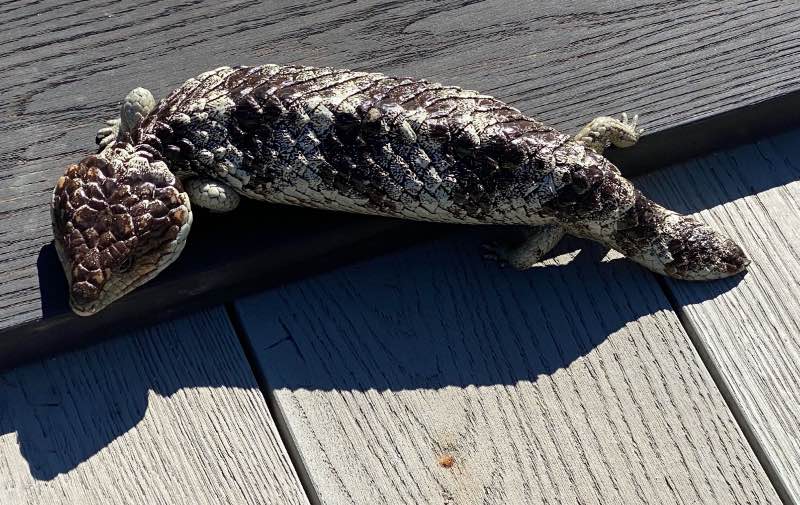
| |
| |
The lizard that I have always previously called the sleepy is generally called the bobtail in WA. The local variant is
Tiliqua rugosa subspecies
rugosa, the eastern variant is
Tiliqua rugosa subspecies
asper.
This was the first lizard that I can recall seeing in the three months that I had been in WA, and to that time I had not seen any snakes at all. It was between Dampier Avenue and the scrub adjacent to the lagoon.
Lizards of many species were common in SA, they seem less common in this area of WA.
Update 2023/02/08
I have now seen three snakes, probably dugites (
Pseudonaja affinis, also called the spotted brown snake) and there are many small skinks about, between about 4cm and 10cm, although they will not usually be noticed until they move for some reason. And I've seen at least one dragon lizard, perhaps a bearded dragon.
| |
This section added
2022/07/26
|
|
| |
|
Update January 2023
I still haven't seen any bats.
|
|
While I have watched for bats on my frequent walks in the early morning and occasionally evening, I don't recall ever seeing a bat in the Mandurah area.
With so many mosquitoes to provide food for microbats I would have expected bats to be quite common.
I did wonder if the frequent aerial treatment, by helicopters, to reduce mosquito numbers had wiped out the local microbat population. But I read information sheets from the City of Mandurah stating that the mosquitoes numbers are controlled with very specific larvicides (S-methoprene) and Bacillus thuringiensis israelensis.
So it seems unlikely that the mosquito treatments would account the the apparent low bat numbers. I've been told that some bat roosting boxes have been placed, so perhaps the low numbers are related to a lack of roosting sites - perhaps that may be connected to the great numbers of dead trees?
| |
This section added
2023/08/03
|
|
These sundews were among a number growing by the concrete path adjacent to Silverton Crescent on the edge of Len Howard Conservation Park.
They are insectivorous plants that supplement the nitrogen that is available from the soil by capturing small insects and digesting them.
Another plant on this page is the curious white algae of the LHCP.
| |
This section updated
2023/01/03
|
|
Many people walk their dogs around the Len Howard Conservation Park area. In the summer months there is very little or no fresh water available for dogs to drink in the area. Someone maintains a watering point mainly for kangaroos in the big seasonal paperbark swamp (I wish there as a shorter and generally accepted name for that) from about the end of the year until about May when water starts to become available in the swamp itself. I'm sure that dogs use it too, although it is difficult for small dogs to use because of the high sides of the container.
There is also a tap at the car park near "Nature's Eye".
| |
This section added
2022/05/06
|
|
Just as around where I used to live in South Australia there is rubbish scattered carelessly around the Mandurah area. I intend to continue
cleaning up this rubbish in my new neighbourhood.
Today I picked up a bag full in the little reserve area at the western junction of Silverton Crescent and Wattleglen Avenue.
It is common for people to dump garden waste in the local parks.
I came across a
shocking amount of rubbish in the patch of scrub adjacent to the Riverside Primary School on 2022/05/09, apparently left by someone who was sleeping rough. I made no attempt to pick it up.
As discussed on another page on this site, there needs to be a noun for the type of careless, irresponsible, lazy people who do this sort of thing.
| |
This section added
2022/06/26
|
|
Senseless vandalism exists in Mandurah as it does in most other parts of the world.
Some hundred or so of the plants I put into Crystal Brook Central Park back in SA were pulled up be one or more vandals. Fortunately, to the time of writing, few of the plants that I've put into a small park near my new home have been damaged by vandals.
Dumping rubbish, discussed above, is a form of vandalism.
Valdalism at the train station car park
I noticed on 2022/07/03 that about a half dozen large recently planted trees adjacent to the new multi-story car park had been broken off. There was only one or two that had been left undamaged. By the 5th they had all been removed.
Vandalism of my tree guards
2022/07/07; see the page on
my projects in the Erskine area.
| |
This section added
2022/07/29
|
|
As is the case with most of the public places with which I am familiar there are weeds in Mandurah, adjacent public paths and in parks and gardens. I find the unwillingness of the great majority of the local people to take part in the improvement of their public places puzzling.
I've written on my efforts to remove some of them on my page titled
Fleabane. I've
speculated on how people look after their private gardens but don't bother with their shared places, and commented on
Whatever happened to civic pride? in relation to the unwillingness of the general public to take part in improving their public spaces. And I've written on
contribution on another page.
I suspect that
selfishness is a factor in people's unwillingness to look after public parks and gardens, as it probably is in the unwillingness of many to
donate blood (only some 3% of Australians donate blood or blood products).
On the subject of selfishness, there are many private jetties in the Mandurah area, most have signs on them telling other
people to keep off. Surely reasonable use by the public would be unlikely to harm the jetties or inconvenience the owners?
I have made a project of working at improving the parks and paths in my local area. It seems to me only natural that I should want to do this. Yet I get the impression that many people find it hard to understand my actions or motivations.
I, in turn, find it very hard to understand their lack of understanding; do they not think that we should care for our public places? Or do they just think, "It's not my job. Let somebody else do it."
| |
Related work
In addition to the onion weed removal that brought about this section, I've also pulled out fleabane and picked up rubbish.
Perhaps the people who can't understand my work at controlling onion weed would find this equally inexplicable?
|
|
About mid July 2022 I was hoeing out onion weeds adjacent to one of the paved trails in the big seasonal paperbark swamp east of my home when a man stopped and asked: "Why are you doing that?" as if my purpose was unimaginable to him. Was he unusual or would it be so incomprehensible to many that a person would want to remove weeds from a conservation park?
2022/07/24, another man stopped and said: "I've got to ask, why are you doing that?" I said something like "I'm digging out weeds; they have no place in a public park."
Several other possible answers came to mind after I had thought about it for a while:
- Would you dig a weed out of your garden? Why then not out of a public park?
- Do you not care about weeds in your public places?
- I dig weeds out of my garden, why should I care less about a public park?
- If I am unwilling to try to improve our public places, why should anyone else?
- If no one cares for our parks what will become of them?
- If you have to ask you will probably not understand my answer.
- This is a beautiful park which the people of Mandurah are very lucky to have. Removing the most conspicuous, unsightly and invasive weeds can only improve it.
Is caring for our shared environment such an uncommon thing to do?
My page on
contribution covers the point in depth. My notes on
self or all and
the rights and needs of future generations are also relevant.
| |
Prime West shopping centre, Erskine, WA
|
|---|
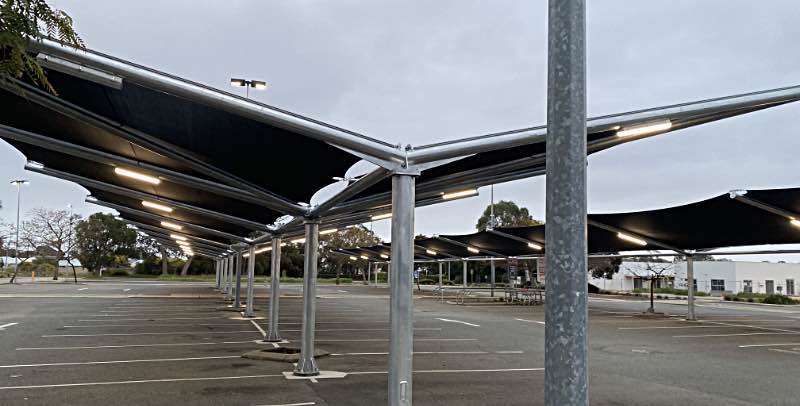
| A great opportunity lost.
And a careless waste of electricity.
| |
In August 2022 car park shades were installed in the Prime West, Erskine, WA shopping centre car park. The shades were plastic mesh, not solar PV panels, a lost opportunity.
Had solar panel shades been installed rather than simple shade sails most of the power consumption of the shopping centre could have been offset and a huge amount of greenhouse emissions avoided (most of Western Australia's power is generated by coal-fired power stations). I estimated that the area covered by the shade sails was 1,320m2, twice that of the Woolworths, Clare, shades, so had solar PV panels been used rather than shade sails the installed capacity would be around 280kW. Such a solar PV installation would generate about 490 megawatt-hours of electricity each year and that could reduce WA's greenhouse CO2 emissions by something like 400 tonnes each year.
I've written a page on solar PV shade in car parks and other places elsewhere on this site.
In 2022 solar PV panels typically pay for themselves in about five years. In this case where the cost of installing the shade cloth sails would have been avoided, the payback time would be shorter. PV panels also have the advantage of casting denser shade than shade cloth, so the cars beneath the panels would be cooler in summer.
A waste of electricity for needless lighting too
Note in the photo too that the lights beneath the shades are on, as are the two tall floodlights that can be seen in this photo. There were about 40 of each types of lights in the shopping centre car park. So far as I have been able to tell all were left on 24 hours a day. The shopping centre is open only from 8am to 6pm most days (Sundays 10am to 5pm, plus to 9pm on Thursdays) so outdoor lighting would only be necessary Thursday evenings and evenings in winter.
On 2022/09/18 I emailed Prime West telling them about the lights being on all the time; I didn't ever receive a response.
On 2022/09/30 I wrote a letter to the local newspaper on both the above points. It was published in at least one (Mandurah Coastal Times) a few days later.
On 2022/10/12 I noticed that the car park lights were off..
One can hint and push but it is a rare thing to get a definite result such as this one. Having the car park lights on only when needed (if that is what happens in future) will reduce greenhouse gas emissions by something like 30 tonnes each year.
Other shopping centre owners are far more progressive
In Western Australia for example Northam Boulevard (
article in The West Australian), belonging to Perdaman Group, 2,211 panels in total, 900 of these shading the carpark, and Dunsborough Centrepoint shopping centre (
article in The West Australian).
In my home state, SA, there are big solar shaded carpark
installations at Vicinity Centres (claimed to be the biggest in Australia at the time of construction, 1,400 panels on the car park alone) and Castle Plaza (430 solar shaded parking spaces).
Also see my page on solar car park shades.
Mandurah is a fast growing city in what was, not so long ago, a mostly undisturbed area. It seems that the soil was too poor for it to be attractive for farming and whatever pastoralism there was didn't much impact the more coastal areas.
However, development has come to Mandurah in a big way in the last few decades.
| |
Seaside vegetation in its natural state
|
|---|
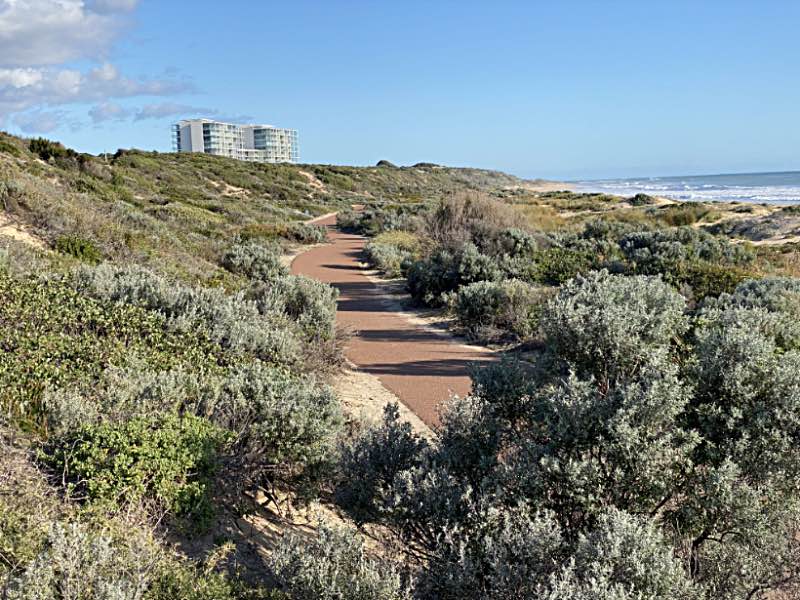
| |
I'm sure that there is a story in these three photos, but I can only guess at what it may be.
This first image was recorded just south of the Dawesville Cut. It seems to be largely untouched native heath vegetation, outside of the shared walking/cycling path.
The high-rise buildings are at The Cut Golf Course.
| |
Tree graveyard
|
|---|
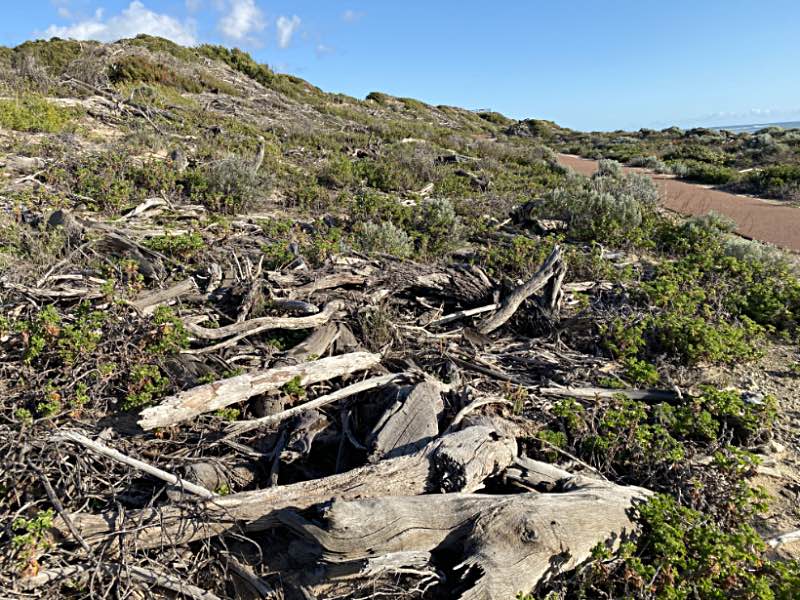
| |
I didn't know what to make of this area when I first came across it, several hundred metres further south than the area in the photo above.
It was the third photo (below) that gave a clue to what happened here.
These photos were all taken with my iPhone 11 Pro on 2023/08/03.
| |
'Developed' golf course
|
|---|
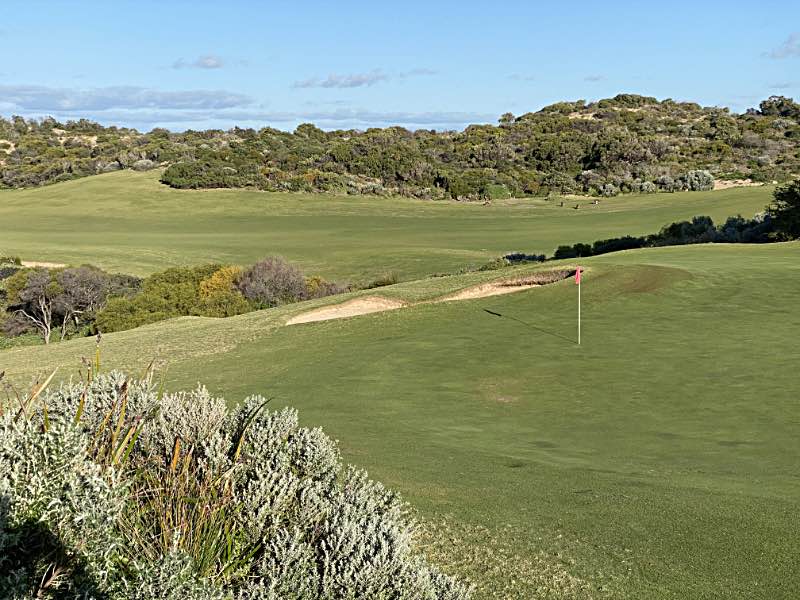
| |
This golf course, "The Cut Golf Course", was on the inland (eastern) side of the foreshore dune and the above photo.
I suspect that when the bush was cleared for the golf course the developers were not allowed to burn all the removed vegetation so they carted it over the foreshore dune and dumped in the 'tree graveyard'.
Google Earth gives the impression that the 'tree graveyard' extends for the kilometre or more of the golf course.
We can only hope that the heath will eventually recover where it has been so greatly disturbed by the machinery and the dumping of the ripped out bush.
Note the kangaroos in the distance on the golf course.
| |
A fence partly obstructing a path
|
|---|
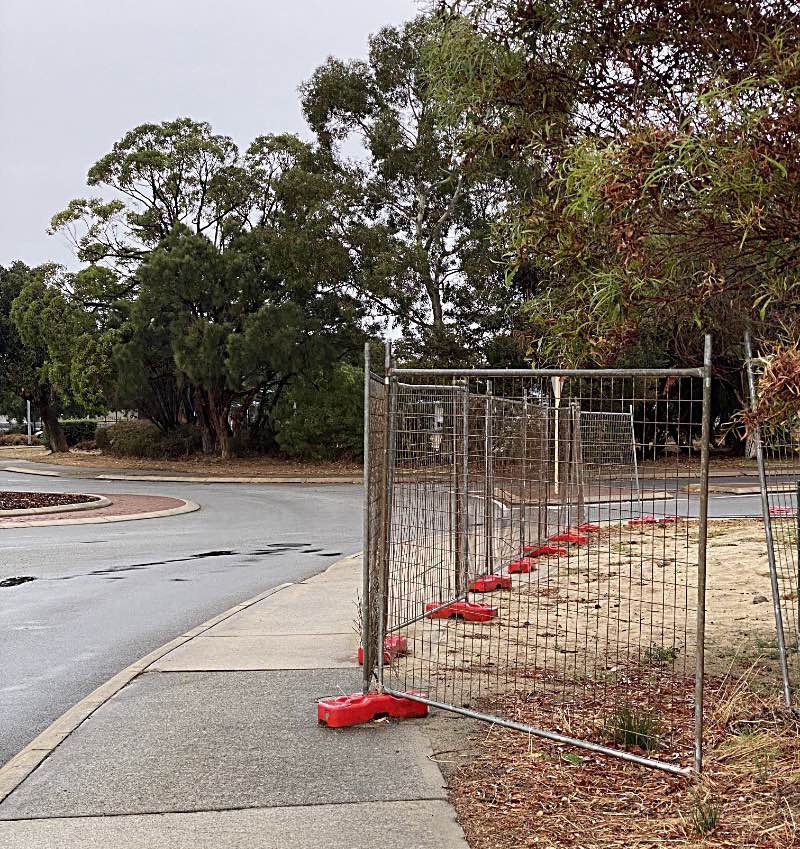
| Thousands of people (including me) have walked past this fence in the more than a year that it has been in place and done nothing.
| |
Many people use that path every day. I’ve used that path many times. The fence was unnecessarily partly obstructing the path adjacent to a busy roundabout and shopping centre for at least a year. It made it harder for cyclists, pedestrians, people with prams, mobility problems, etcetera to pass each other; and there was the danger of a vehicle-pedestrian accident.
Why were we all so unwilling to do something about it? I suspect it didn’t occur to most of us that we could do something about it.
Why did the council allow the fence to encroach on the path when there was no need for it? Why did I put up with it for so long before I did something about it?
I've written more on this subject on another page on this site.
| |
This section added
2023/11/17
|
|
I intend to observe the recovery of the bush in this area over the next few years.
| |
The burned area
|
|---|
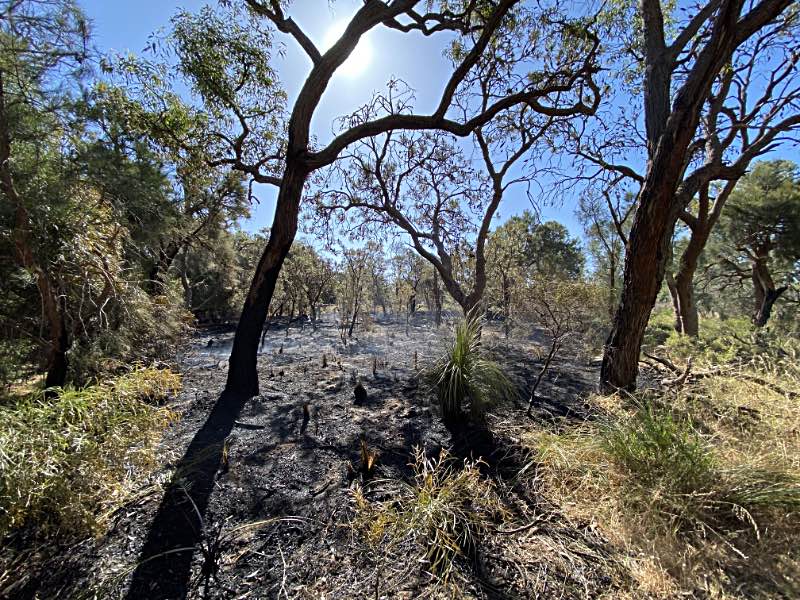
| The day of the first fire, 2023/11/15
| |
There was a fire in a small reserve near my home in Erskine. I was informed by a firefighter who was there later in the day extinguishing smouldering remnants that it was not a controlled burn. It seems likely to have been lit by a fire bug.
I have adopted some responsibility for removing invasive weeds in this reserve as recorded on another page on this site. I've called it the W/S (Wattleglen/Silverton) reserve for the adjacent roads and because it seems to have no formal name. About a quarter of the little reserve was burned.
Photo iPhone 11 Pro, wide angle lens, 1.54mm fl, 2023/11/15, the day of the fire
Update
There was another fire in the same little patch of scrub on 2023/11/18. I noticed three burned patches in a chair that I had placed in the reserve a few months earlier. The chair was about 30 metres on the upwind side of the fire, so it would seem very unlikely that the burned patches were caused by sparks from the fire. I estimated that between the two fires two thirds of the reserve has been burned. I've heard that it was a 12 year-old boy who lit both fires and that the police had been informed.
| |
This section added
2024/05/04
|
|
| |
After a long, hot, dry summer
|
|---|
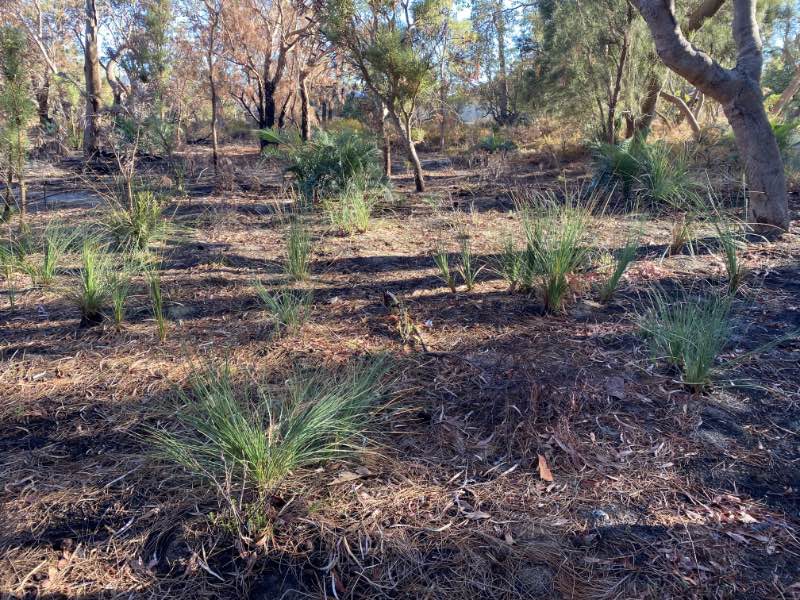
| Photo iPhone 11 Pro, 2024/05/04
| |
This photo was taken a couple of days after the first significant rain of 2024 following the
very dry five months from the beginning of December 2023 to the beginning of May 2024.
There was 4.4mm over the five months, and 30mm in the first few days of May.
After the fires in 2023/11/15 and 18th there was ten millimetres of rain in late November then 4.4mm in the following five months.
Remarkably, in spite of the long, hot, dry summer (one of the hottest and driest on record), there was a lot of regrowth in the little reserve. After having all been burned right down to ground level, as can be seen in the photo taken the day of the fire, some of the small yaccas had grown up to 90cm high.
The top 10cm or so of leaves on many had died and gone brown, perhaps this was due to stress from the lack of moisture.
| |
Lake Goegrup
|
|---|
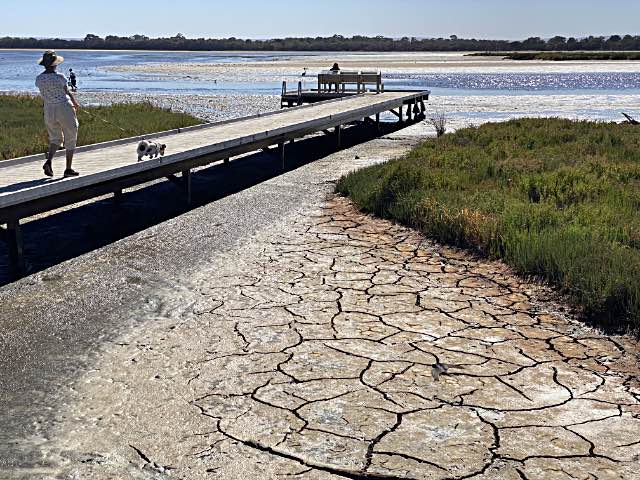
| |
There was an exceptionally low tide in the few days around 10th December 2023.
The local newspaper reported that two young dolphins were stranded in this lake, twice.
It seems that the very low water levels were due to strong and persistent offshore winds.
Photo iPhone 11 Pro, telephoto lens, fl 6.0mm; 2023/12/11, 08.52
A record of the tides; the black line on the graph shows what the calculated tide was expected to be, the blue line shows the actual recorded tide level.
The red line on the lower graph shows the difference between the two.
It reached a maximum of about 0.33m about 3am on the morning of Sunday 10th.
It seems that the tide recording station in near the mouth of the Peel estuary, quite a way from Lake Goegrup.
CSIRO: Australia's changing climate; a quote...
"The drying trend is particularly strong between May to July over southwest Western Australia, with rainfall since 1970 around 20 per cent less than the average from 1900 to 1969. Since 1999, this reduction has increased to around 26 per cent."
(I have expanded on this on
another page on this site.)
Do the people of Mandurah respond to this obvious and very important local change in the climate by changing their lifestyle in any way? It would seem not. Just one example: I've seen that at least on the one occasion that I made an observation and simple calculation, only about 1% of the local people use busses rather than driving.
